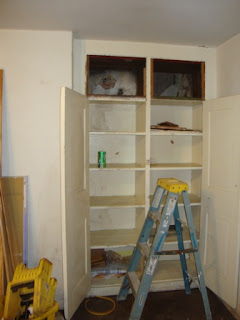 Pavilion IX is undergoing a comprehensive renovation. The Office of Facilities Management and the Office of the Architect are updating the electrical, heating, cooling and other systems. In the process of making way for the new, you sometimes find vestiges of the old. Take a look at this cupboard in the basement of the Pavilion.
Pavilion IX is undergoing a comprehensive renovation. The Office of Facilities Management and the Office of the Architect are updating the electrical, heating, cooling and other systems. In the process of making way for the new, you sometimes find vestiges of the old. Take a look at this cupboard in the basement of the Pavilion. Now take a closer look at the top two shelves of the cupboard. What do you see? The back of the shelves look a little different, they're not painted like the rest of the cupboard. What's in there? The Architectural Conservator for the University had some ideas, but asked me to take a look.
The back of the cupboard has wallpaper that just might be original to the building. A curator that I consulted had this to say: "The wallpaper is an ashlar block design which was very popular during the first half of the 19th century. They were frequently used as dado papers below the chair rail, or in the entry way to suggest solidity and grandeur." Since this paper is in the back of a cupboard it might be a scrap that is left over from an installation in another part of the building that no longer survives. The paper extends behind the frame of the cabinets, so we can only speculate whether it was placed to decorate the back wall of the cabinets or the cabinets were placed over the wallpaper as part of the changing function of the
 room.
room. But the plan is to leave the wall paper in place, "in situ" and just mend the torn edges so the remnants don't become more tattered. Research on the history of the buildings is ongoing and new information is gathered every time a building is renovated or altered. By leaving the wallpaper in situ, we ensure another opportunity for examination and research that might match up with some other detail about the building that is revealed years down the road.


No comments:
Post a Comment